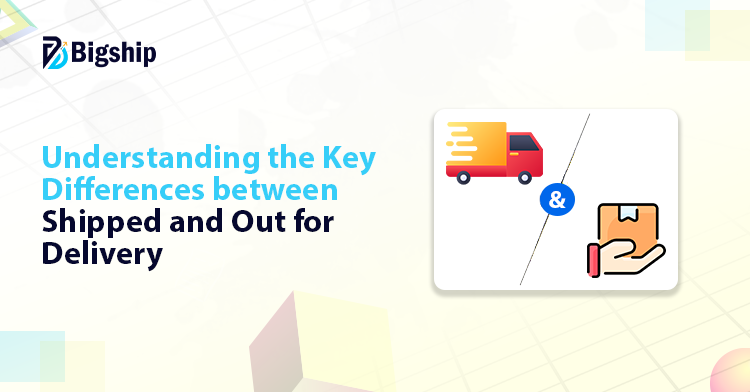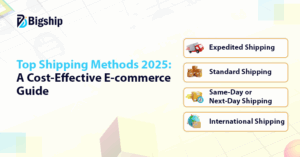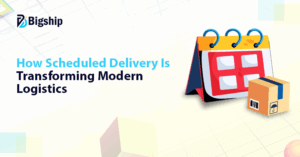When you’re tracking your online order, it may show status updates such as Shipped or Out for Delivery. These sound similar at first because both merely indicate that your item is moving; however, they hold two very different places in the delivery process.
Shipped means your order has left the seller’s warehouse and is going through the shipping network. On the other hand, out for delivery means that your package is with the delivery person and will probably reach you the same day, generally.

Shipped means it is on its way, while out for delivery means it is nearly there.
Now, let us take an in-depth look to understand it better.
Understanding Common Delivery Status
It’s helpful to understand the delivery journey before it arrives at your doorstep. The delivery process has three key stages-
1. Receiving the order-
The journey starts with the customer placing an order. The seller has to ensure that the actual item is in stock or not. This usually involves:
- Checking inventory in the warehouse.
- Coordinate with manufacturers or suppliers if an item does not have enough stock available.
- Communicate with third-party logistics partners like FedEx, UPS, or DHL.
Many businesses have now turned to logistics management software to set up these against checks, speed up delivery, and lower shipping costs of which translates into faster, less costly delivery options for their clients
2. Processing the Order
Once the item’s availability is confirmed, the order moves to the processing stage. This step includes:
- Verifying the customer’s contact and shipping information.
- Confirming payment and order details.
- Generating a tracking number and shipment label.
3. Order Fulfillment
Fulfillment is the final phase: getting the package into your hands. This can involve:
- Packing: The item is properly packed in such a way that it travels safely.
- Transporting: Taking the package onto the vehicle that will be shipping it.
- Delivering: A driver brings the finished package to your address.
During this stage, consistent tracking reports indicate packing, shipment processes, and finally, delivery confirmation.
What Does “Shipped” Actually Mean?
When you place an order online does not mean that’s shipping occurs immediately. The seller has to first process your order, which consists of packing, labeling, and sometimes even manufacturing the item if it is out of stock.
Shipping officially starts when the seller has packed your package and handed it over to a courier, it can be either FedEx, DHL, or sometimes they might even use their delivery service like Amazon Logistics.
With express shipping, packages arrive in 1-3 days. Standard shipping may take longer and can take between 2-8 days. A further bonus is that parcels shipped by air reach the destination faster than those shipped by land.
What Does “Out for Delivery” Mean?
Out for Delivery means your driver has picked the package up from the local fulfillment center and is now going to your address. It is known that the parcel had departed from the last sorting place and into the hands of a driver, who will try to deliver it the same day. Normally, a package is expected to be delivered on the same day once it is marked Out for Delivery; however, under some circumstances, it may show up the next day.
Shipped” vs “Out for Delivery” – Key Differences
The two statuses might appear to be somewhat similar. However, knowing their differences can help you better understand the movement of your package for delivery expectations and timing, tracking accuracy, and shipping.
Let’s analyze it further.
Shipped: Shipped means that your package has left the warehouse or fulfillment center and is now traveling through the carrier’s network.
Tracking becomes increasingly frequent since the shipping phase generally provides more estimated arrival times based on the shipping method and distance.
Out for Delivery: Out for Delivery means that your parcel has reached that part of the world and is on a vehicle heading to your place.
Once an item has been categorized as “Out for Delivery,” tracking now becomes much more precise and real-time.
Common Scenarios in the “Out for Delivery” Phase
1. Successful First Attempt
The delivery agent drops off the parcel and scans the package. He then updates the system to indicate the delivery. Sometimes, if the recipient is not available, the package might have to be dropped off with either a neighbor or a receptionist.
2. Miscommunication or Tracking Errors
However, sometimes the delivery driver forgets to scan the package during delivery.
Because the package has actually gone under the definition of “out for delivery,” the result is that the end-user doesn’t know it has ended.
3. Unsuccessful Delivery Attempts
First delivery attempts can be unsuccessful for the following reasons: Weather constraints, restricted access to the address (gated communities or commercial buildings), signature or payment required on delivery.
4. Sorting and Return to Sender
After a certain number of attempts to deliver the package, the carrier returns it to the sender.
Different carriers have different numbers of attempts made and the lengths of time they wait before returning.
Factors That May Delay a Delivery Marked “Out for Delivery”
Frustrating, it could be when a package that was tagged “Out for Delivery” does not turn up the same day. However, in between, there may be many factors urging an unexpected delay:
1. Proof of Delivery Requirements
Signature or digital confirmation is required in certain cases. If nobody was there to receive it, the driver would leave a notice for you to either collect it from the local distribution center or wait for the second attempt.
2. Delivery Exceptions
Things that interfere with the normal delivery course are called exceptions. Adverse weather, breakdowns, accidents, or other unplanned changes in logistics may hinder deliveries. Drivers may use such exceptions to defer deliveries, sometimes to the next available day.
3. Inaccessible Delivery Locations
Drivers encounter access issues to some delivery locations due to locked gates, no business closure, and unrestrained but unfriendly pets (such as protective dogs). The driver will either reroute or leave a notice informing you on how to proceed.
4. Communication Gaps and Human Error
Mistakes have to take place, resulting in scenarios such as:
- Wrong Truck Loading – If you have loaded the wrong vehicle with some packages, these start being rerouted, and consequently lead to a delay.
- Erroneous Tracking System Updates: Erroneous updates can only confuse you about the real-time whereabouts of your parcel.
- Scanning Issues: Sometimes, packages may be delivered without scanning or mistakenly scanned as delivered; there may be times when they end up at a neighbor’s address by accident.
What to Do If Your Package Doesn’t Arrive
It’s complicated to track your package and see it declared “Out for Delivery” only for it to fail to show up. Some steps you should follow if your package does not arrive on time:
- Check the Tracking again: Delivery companies sometimes encounter other delays that rarely allow immediate updates to tracking pages. Check if something like “Attempted Delivery” or changes in the expected delivery window takes place.
- Ask Your Neighbors or Anyone Else at the House: Delivery persons sometimes drop off packages with the neighbors or other hidden spots around your house for good reasons. Check with anyone who might have been at your address that day, or any of your neighbours.
- Contact the Delivery Service: If the package was marked “Out for Delivery” but did not arrive until the end of the day, get in touch with the delivery service for further details. They can verify whether any problems arose or whether it is just delayed.
- Contact the Retailer: In case the shipping company provides you with no useful information, the next step would be to get in touch with the retailer who sent the package. They may escalate the issue or offer solutions such as issuing a refund or sending out a replacement.
Real-Time Tracking & Delivery Notifications – Why They Matter
Waiting for a package can be stressful, especially if one isn’t aware of its arrival schedule. This is where real-time tracking and delivery notifications add great value.
Improved Customer Experience: With real-time tracking, customers can follow the journey of their package from start to finish. The updates bring down uncertainty and keep them aware at every turn, helping to manage expectations instead of promises broken.
Reduced Anxiety: By giving information at each stage of the journey, the real-time alerts help them plan well ahead. When a parcel goes out for delivery, the recipient can get ready for its arrival at home without having to worry about when it might arrive.
Optimising deliveries: Real-time tracking isn’t just for customers, it’s also an essential tool for optimizing routes and schedules. It helps the driver to manage the time so that they can prevent unnecessary delays and produce a quicker delivery.
Tips for Customers to Expedite and Manage Deliveries
When it comes to ensuring timely package deliveries, the recipient can take several proactive steps to speed up the delivery and avoid unnecessary delays. Your information may help speed up the delivery of packages by the carriers. Here’s how:
Stay Updated with Tracking Tools: Check out the tracking systems provided by the major carriers, like FedEx or DHL. Through real-time tracking, you can observe your package and remain ready when it is near your locality.
Prepare for Signatures and Payment Requirements: If signatures or payment of fees are needed for the delivery, then be available at the delivery address.
Set Up Redelivery or Pickup Options: Life happens- if you missed the first delivery attempt, don’t delay. Arrange for a second delivery or a quick pickup from a nearby collection point. Quick action prevents from getting delays or even a return to the sender.
Be Flexible with Delivery Windows: Even with real-time tracking, occasional delays can occur due to traffic, weather, or other unforeseen issues. When your package is marked as “Out for Delivery,” give yourself an extended grace period of up to 48 hours to accommodate any expected interruptions.
How Shippers Can Optimize the ‘Out for Delivery’ Process?
To ensure smooth and cost-effective deliveries that satisfy customers, shippers need to optimize the ‘out for delivery’ phase with key strategies:
- Using Technology: Use the power of real-time tracking, route optimization, and communication amongst drivers, shippers, and customers.
- Proactive Communication: Another thing to do is to keep customers updated via SMS, emails as well as notifications through the app.
- Offering Flexible Delivery Options: Let customers choose from standard, same-day, scheduled, or time-specific deliveries such that they provide first-attempt success in case anything has to be reattempted at less price.
Conclusion
Understanding the difference between “Shipped” and “Out for Delivery” helps you manage your delivery expectations better. Tracking tools, proactive steps, and clear communication can make the process smoother for both customers and sellers. Whether you’re waiting for a parcel or managing deliveries, being informed ensures fewer surprises and a more satisfying delivery experience.
In this, Bigship helps you streamline shipping and delivery by providing real-time tracking and smooth logistics.
Sign up with Bigship today to simplify your shipping process!





